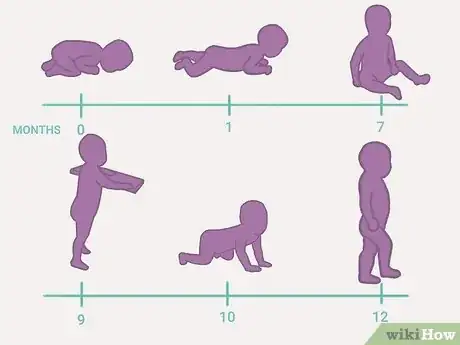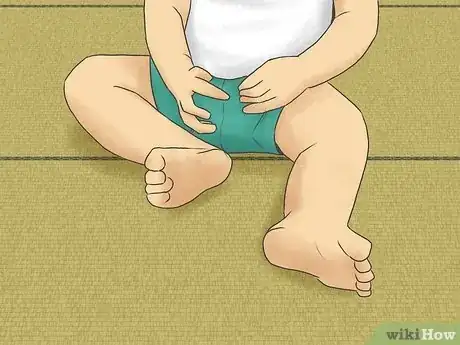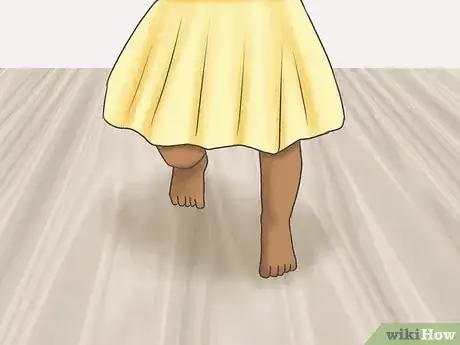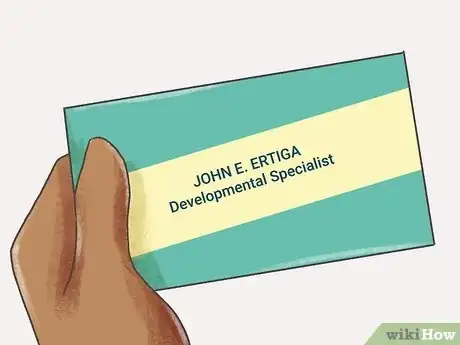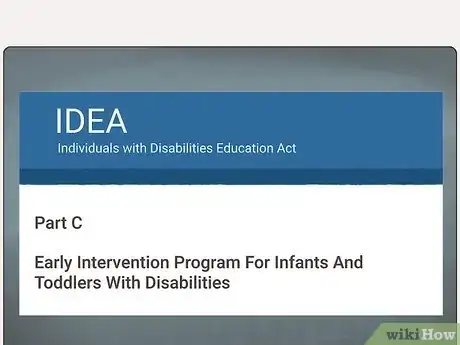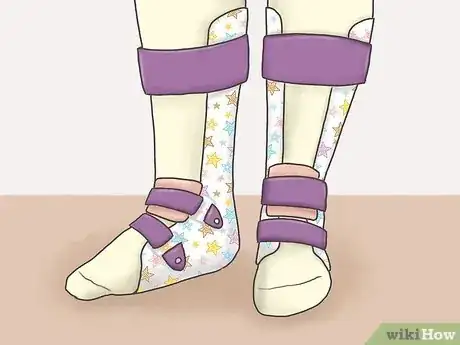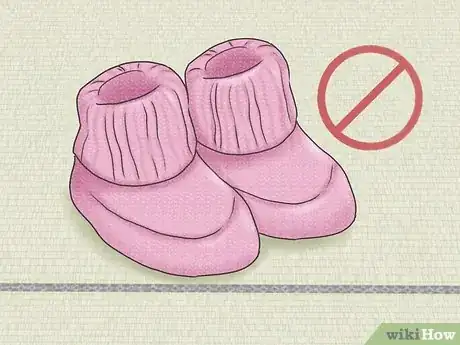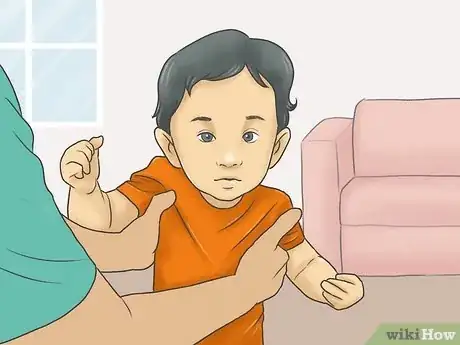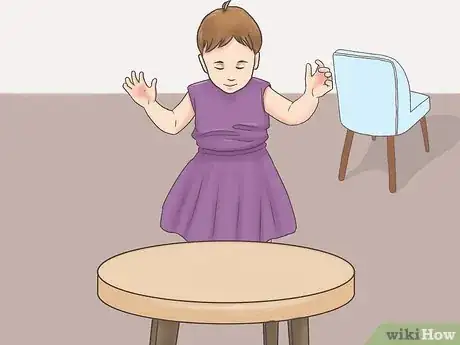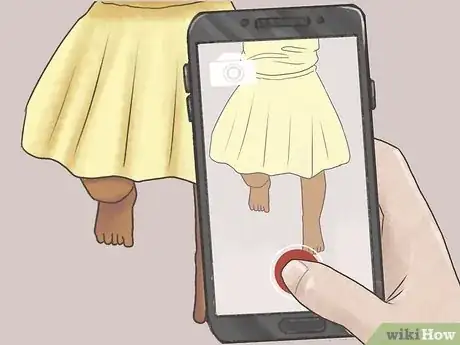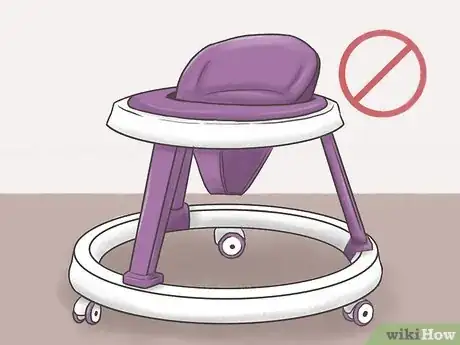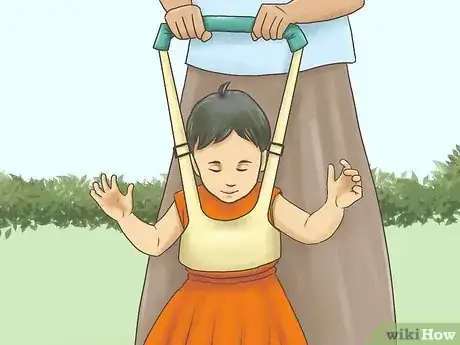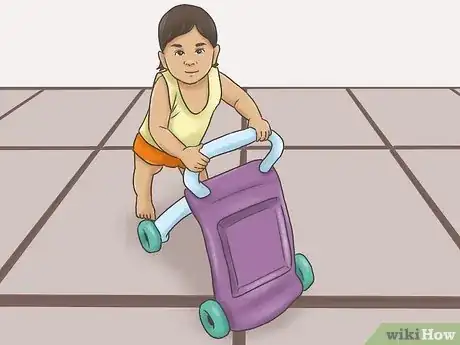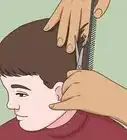This article was co-authored by Kylee Money. Kylee Money is a Parenting Consultant and the Founder and CEO of Parenting Made Joyful. Since 2001, Kylee has worked with over 1,000 parents and families on sleep training, behavior management, potty training, and more. She is a contributing writer and board advisory member at Pampers.com, a CBS News Parent Expert, and featured on Fox and Friends and Buy Buy Baby. Kylee also speaks nationally at parenting expos on the subject of sleep training.
There are 17 references cited in this article, which can be found at the bottom of the page.
This article has been viewed 73,577 times.
Teaching your toddler to walk can be exciting and nerve-wracking. Your goal is to help your child succeed while supporting him or her and providing a safe environment where they can learn their new skill. Practice some safe and easy steps to help get your child on their feet and independent.
Steps
Determining if Your Toddler is Ready to Walk or Experiencing a Delay
-
1Check your toddler’s timeline. Understanding the general timeline of expectations for your child’s development will help you understand whether they are on track and ready to begin walking. All children are different, but it’s good to have a rough guideline of when most children make strides toward walking.
- Most toddlers begin walking between 12 and 15 months, but this milestone can happen any time between 9 and 12 months.[1]
- Babies will have a step reflex between birth and 2 months. They will move their legs in a walking motion when held upright with their feet on a hard surface. This fades after 2 months.
- At 3-4 months, children will begin lifting their upper body when lying on their stomach.
- 5 months brings bouncing while held in a standing position as well as beginning to support themselves by leaning forward on their arms when seated.
- Children learn to sit unsupported between 6 and 9 months, and beginning crawling between 7 and 10 months. They will be able to stand if positioned where they can hold onto something like a table or chair, and begin “cruising,” or scooting their feet as they move along the edge of their support.
- Pulling up into a standing position occurs between 9 and 12 months.
-
2Assess whether your child is ready to walk. If your child is already sitting, crawling, pulling up and cruising, he or she may be ready to walk. If they haven't conquered these skills yet, they will need a little time to work their way up to walking.[2]Advertisement
-
3Encourage your child’s gross motor development. Several muscles are involved in walking, so you can try some exercises to strengthen their core and legs to help prepare your child for walking.
- Give your child some “tummy time.” Place your child on the floor on his stomach for about 10 minutes at a time. Encourage your child to push up and propel his or herself forward by placing toys or treats just out of the child's reach.[3]
- Try lying your child on his or her back on a balance ball and assisting the child in sit-ups. Lie the child on their back, keeping a good grip so they don't fall. Tickle the baby's tummy and help bend the child back up into a sitting position on the ball.[4]
- Hold your child in a standing position on a bouncy surface, like a balance ball, trampoline or soft bed. Holding the baby around the rib cage, lift them slightly off the surface and lower them back down, encouraging them to bounce and strengthen their leg muscles.
-
4Understand that most children do not need to be taught how to walk. If your child is developing in a typical fashion, these milestones will come naturally. Some children may take longer to reach each milestone. Have patience and encourage your child as he or she follows their own timeline.
-
5Ask your doctor. There are several reasons why your child may be falling behind, or be a delayed walker. Some children simply take longer than others and you likely have no reason to panic. If you are concerned about your child’s development, it is best to check with your doctor to find the cause of the delay.[5]
- Hypotonia, sometimes referred to as “floppy infant,” is a decrease in muscle tone. There can be several causes of hypotonia, and it is best to check with your doctor for testing.[6]
- Hypertonia is a stiffness in the muscles on either one or both sides of the body from increased muscle tone. This tends to appear around 2 to 3 months.[7]
- Other causes can be related to delayed development. Consult your doctor to determine what may be hindering your toddler.
-
6Get a referral for a developmental specialist. Your pediatrician is the doctor who knows your child the best, but no one know your child better than you do. If you feel that your toddler is experiencing a delay, schedule an appointment of at least 30 minutes with your pediatrician to ask questions and request a referral to a specialist who can really explore your child’s development.
- Bring notes listing your child’s timeline and marking their developmental milestones.
- Be prepared to talk about family medical history, anything you have noticed which has caused concern, and play patterns.
- Keep a daily record of your child’s activities, diet and behavior for 2 weeks prior to the visit to see if you can notice any patterns.
- Consider sending your daily notes and a letter explaining your concerns prior to the visit and asking your pediatrician to look over them before the appointment to prepare for the conversation.
-
7Begin early intervention to help a child who has been diagnosed with a developmental delay. If you are a citizen of the United States of America, you could be eligible for Part C of the IDEA Act, which grants services to children up to 2 years old.[8]
- Early intervention is more effective and less costly than addressing delays which have persisted.[9]
- If your child has been diagnosed with a delay, begin intervention early for the most positive outcomes and quick results.
-
8Consider using orthotics to treat hypotonia. Orthotics can give your toddler a support system as they are learning to walk. Orthotics can help align the feet as well as give your child the balance they need to begin walking.[10]
Increasing Walking Skills
-
1Encourage your toddler to walk instead of crawl. If your toddler seems to be on track to begin walking, encourage them to try. Your toddler may be tempted to crawl instead of walk, because it may be easier for them. Once your toddler has learned to pull themselves up to a standing position, try to get them to choose walking over crawling.[11]
- Entice them with games, toys and treats.
- Celebrate their attempts at walking.
- Don’t try to make them walk when they don’t want to. This could create further resistance to walking.
-
2
-
3Support your toddler when they are in a standing position. Set them down in a standing position. If you have been holding your child, when you set the toddler down, place them on their feet instead of a sitting position on the floor. Follow behind them, walking on your knees or crouched down to offer gentle support with your hands.[14]
- Start by supporting the toddler at the ribs as you encourage them to take steps, then move to supporting them at their hips to encourage core strength. Once they are ready to walk on their own, only support them by holding their hands.
- Do your best not to raise your baby's hands above their head, because then they aren't truly balancing on their own and learning how to walk independently.[15]
- As they become more comfortable, just have a hand stretched toward them, to signify to the toddler that you will catch them if they tumble.
-
4Conquer the fear of falling. A toddler may delay learning to walk if they are afraid of falling. Help alleviate this fear to encourage them to take steps on their own.[16]
- Make a path with furniture. Line chairs along the wall to give the toddler something to hold on to. Make sure that the furniture is steady, can support the toddler and won't slide. Also avoid any furniture with sharp edges.
- Eventually you can increase the distance between the pieces of furniture, requiring your toddler to take steps on their own to get from one piece to the next.
- Don’t overreact when your toddler falls. If you do, it could scare them.
-
5Entice them with treats or toys. Once your child begins cruising, give them a goal to encourage them to keep moving. Place objects like favorite toys or snacks out of the toddler's reach. Put the items on a chair, or dangle them in your hand to encourage them to stand and walk.
- Place the chair with the treat near the furniture they are using for support, but far enough away that they will need to take some steps on their own in order to reach it.
- You can also give them another person to walk toward.
-
6Celebrate the first steps. This is a huge success for your little one. Make sure that they know it by cheering and making happy noises.[17]
- Once your child begins to walk, they may get very excited and move quickly into a run.
- Have a camera ready each time you have your toddler practice walking so you’re ready to capture the special moment when they walk on their own!
Using Walking Aids
-
1Avoid walkers. The tide has turned against baby walkers and many people will warn you against using them due to delaying development of motor skills as well as high risk of injury to your toddler.[18]
- Just 24 hours of using a walker can result in delays in excess of 3 days for walking and standing on their own.[19]
- Walkers allow the toddler to move at a faster speed than normal, as well as giving them access to things they would not normally be able to reach.
- Canada considers the use of walkers so dangerous, that they banned them in 2004.
-
2Strap on some walking wings. This is a product created to assist in supporting your toddler from the ribs rather than pulling up on their arms, which could lead to injuries.
- Strap the padded vest around the toddler’s ribs.
- Hold a loop in each hand above each of the toddler’s shoulders.
- Pulling up slightly to give the toddler support, begin moving them forward one step at a time.
-
3Provide push and pull toys. This will give your child something to hold onto as they explore moving around the house on their feet. They will have the support of an object which moves with them.[20]
- Find a toy which is heavy enough to support your toddler and has a wide base for balance.
- Start with a push toy. This will be easier for them to use and encourage them to move forward while looking straight ahead.
- Consider a toy which is a miniature version of something your toddler has seen you use, like a mini shopping cart full of toys.
- Pull toys, like wagons, are more complicated and can tempt the toddler to look behind them instead of where they are going. Make sure their path is cleared of obstacles.
Expert Q&A
-
QuestionAt what age do babies walk without support?
 Jessie DavidsonJessie Davidson is a Child Care Specialist and the CEO and Founder of BabysitPro, which provides online courses for current and aspiring babysitters. Jessie has over 20 years of childcare experience and specializes in best practices for sitters of infants, toddlers, preschoolers, and grade-schoolers. BabysitPro’s courses are unique and age-specific so babysitters can learn detailed information relevant to the children they babysit. Jessie holds a BA in French Studies from Wheaton College and an MA in Visual Anthropology from The University of Southern California.
Jessie DavidsonJessie Davidson is a Child Care Specialist and the CEO and Founder of BabysitPro, which provides online courses for current and aspiring babysitters. Jessie has over 20 years of childcare experience and specializes in best practices for sitters of infants, toddlers, preschoolers, and grade-schoolers. BabysitPro’s courses are unique and age-specific so babysitters can learn detailed information relevant to the children they babysit. Jessie holds a BA in French Studies from Wheaton College and an MA in Visual Anthropology from The University of Southern California.
Child Care Specialist A lot of babies start walking without support when they're 12 months old, but this milestone can happen anywhere between 9 and 17 months.
A lot of babies start walking without support when they're 12 months old, but this milestone can happen anywhere between 9 and 17 months. -
QuestionWhat are signs that a baby will start walking?
 Jessie DavidsonJessie Davidson is a Child Care Specialist and the CEO and Founder of BabysitPro, which provides online courses for current and aspiring babysitters. Jessie has over 20 years of childcare experience and specializes in best practices for sitters of infants, toddlers, preschoolers, and grade-schoolers. BabysitPro’s courses are unique and age-specific so babysitters can learn detailed information relevant to the children they babysit. Jessie holds a BA in French Studies from Wheaton College and an MA in Visual Anthropology from The University of Southern California.
Jessie DavidsonJessie Davidson is a Child Care Specialist and the CEO and Founder of BabysitPro, which provides online courses for current and aspiring babysitters. Jessie has over 20 years of childcare experience and specializes in best practices for sitters of infants, toddlers, preschoolers, and grade-schoolers. BabysitPro’s courses are unique and age-specific so babysitters can learn detailed information relevant to the children they babysit. Jessie holds a BA in French Studies from Wheaton College and an MA in Visual Anthropology from The University of Southern California.
Child Care Specialist A baby might pull themselves up on furniture, squat to grab a toy before standing up again, or walk with their hands on nearby furniture as a support. If they enjoy standing and scooting around the furniture, that might be a sign that they're ready to walk with your support.
A baby might pull themselves up on furniture, squat to grab a toy before standing up again, or walk with their hands on nearby furniture as a support. If they enjoy standing and scooting around the furniture, that might be a sign that they're ready to walk with your support. -
QuestionHow can I help my baby learn to walk?
 Jessie DavidsonJessie Davidson is a Child Care Specialist and the CEO and Founder of BabysitPro, which provides online courses for current and aspiring babysitters. Jessie has over 20 years of childcare experience and specializes in best practices for sitters of infants, toddlers, preschoolers, and grade-schoolers. BabysitPro’s courses are unique and age-specific so babysitters can learn detailed information relevant to the children they babysit. Jessie holds a BA in French Studies from Wheaton College and an MA in Visual Anthropology from The University of Southern California.
Jessie DavidsonJessie Davidson is a Child Care Specialist and the CEO and Founder of BabysitPro, which provides online courses for current and aspiring babysitters. Jessie has over 20 years of childcare experience and specializes in best practices for sitters of infants, toddlers, preschoolers, and grade-schoolers. BabysitPro’s courses are unique and age-specific so babysitters can learn detailed information relevant to the children they babysit. Jessie holds a BA in French Studies from Wheaton College and an MA in Visual Anthropology from The University of Southern California.
Child Care Specialist Bend down or walk on your knees behind the baby, with your hands gently supporting one or both of their hands. Try not to lift their hands over their head as you support them.
Bend down or walk on your knees behind the baby, with your hands gently supporting one or both of their hands. Try not to lift their hands over their head as you support them.
Warnings
- Do not force a toddler to walk as this could upset the child⧼thumbs_response⧽
- Do not let your child walk near furniture with sharp edges.⧼thumbs_response⧽
- Do not push a child to walk too early as his legs may not be ready to support him. He will walk in due course.⧼thumbs_response⧽
References
- ↑ Jessie Davidson. Child Care Specialist. Expert Interview. 7 July 2021.
- ↑ Jessie Davidson. Child Care Specialist. Expert Interview. 7 July 2021.
- ↑ http://www.parents.com/baby/development/physical/building-babys-strength/
- ↑ https://www.youtube.com/watch?v=uRxz3X2dMgM
- ↑ http://patient.info/doctor/delay-in-walking
- ↑ https://www.nlm.nih.gov/medlineplus/ency/article/003298.htm
- ↑ http://www.brainandspinalcord.org/cerebral-palsy/types/spastic-diplegia.html
- ↑ http://www2.ed.gov/programs/osepeip/index.html
- ↑ http://www.nectac.org/~pdfs/pubs/importanceofearlyintervention.pdf
- ↑ http://lermagazine.com/special-section/surestep/orthotic-solutions-for-children-with-hypotonia
- ↑ http://www.parents.com/baby/development/walking/help-baby-learn-to-walk/#page=10
- ↑ Kylee Money. Parenting Consultant. Expert Interview. 21 May 2021.
- ↑ http://www.newkidscenter.com/How-to-Encourage-Babies-to-Walk.html
- ↑ Jessie Davidson. Child Care Specialist. Expert Interview. 7 July 2021.
- ↑ Jessie Davidson. Child Care Specialist. Expert Interview. 7 July 2021.
- ↑ http://www.whattoexpect.com/first-year/first-steps/
- ↑ http://www.parents.com/baby/development/walking/help-baby-learn-to-walk/#page=9
- ↑ http://consults.blogs.nytimes.com/2010/02/22/the-dangers-of-baby-walkers/
- ↑ http://www.bmj.com/content/324/7352/1494
- ↑ http://www.babycentre.co.uk/a556917/pushing-and-pulling-toddler-development
